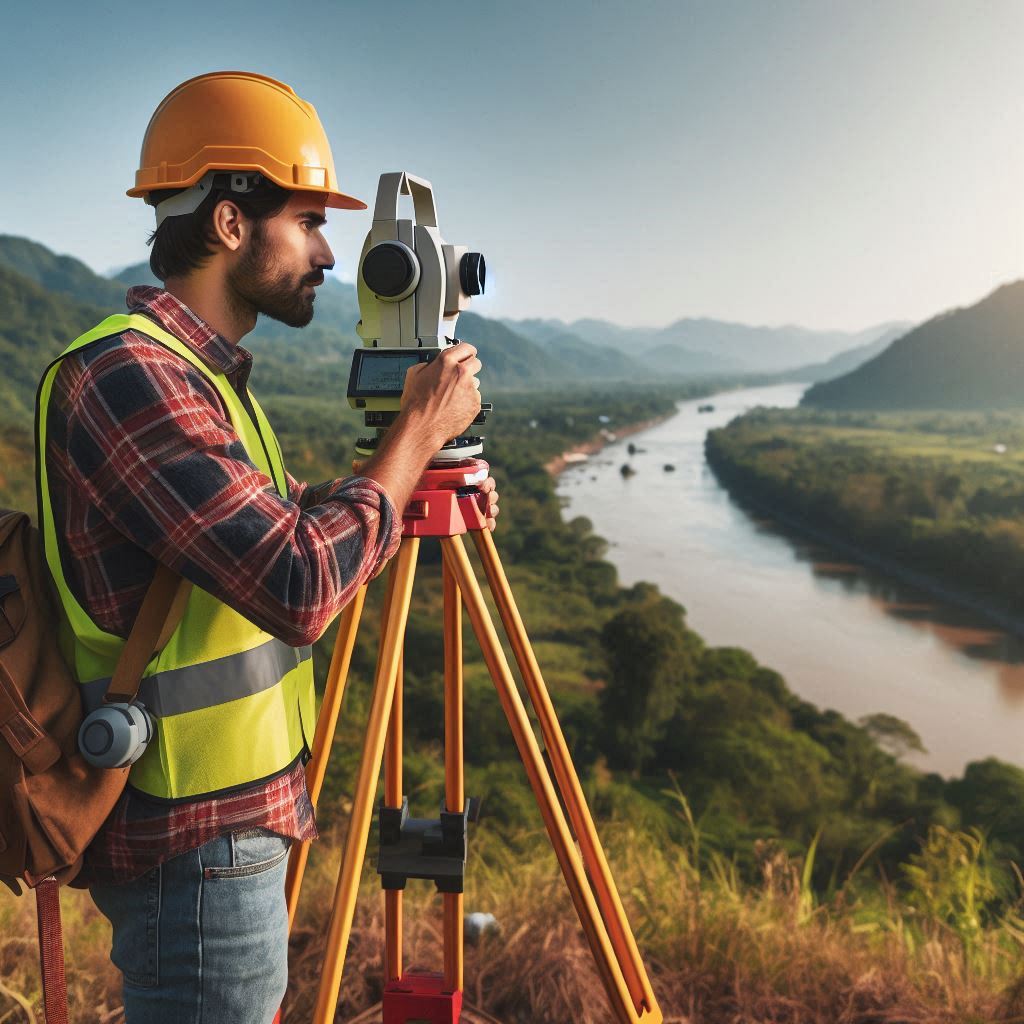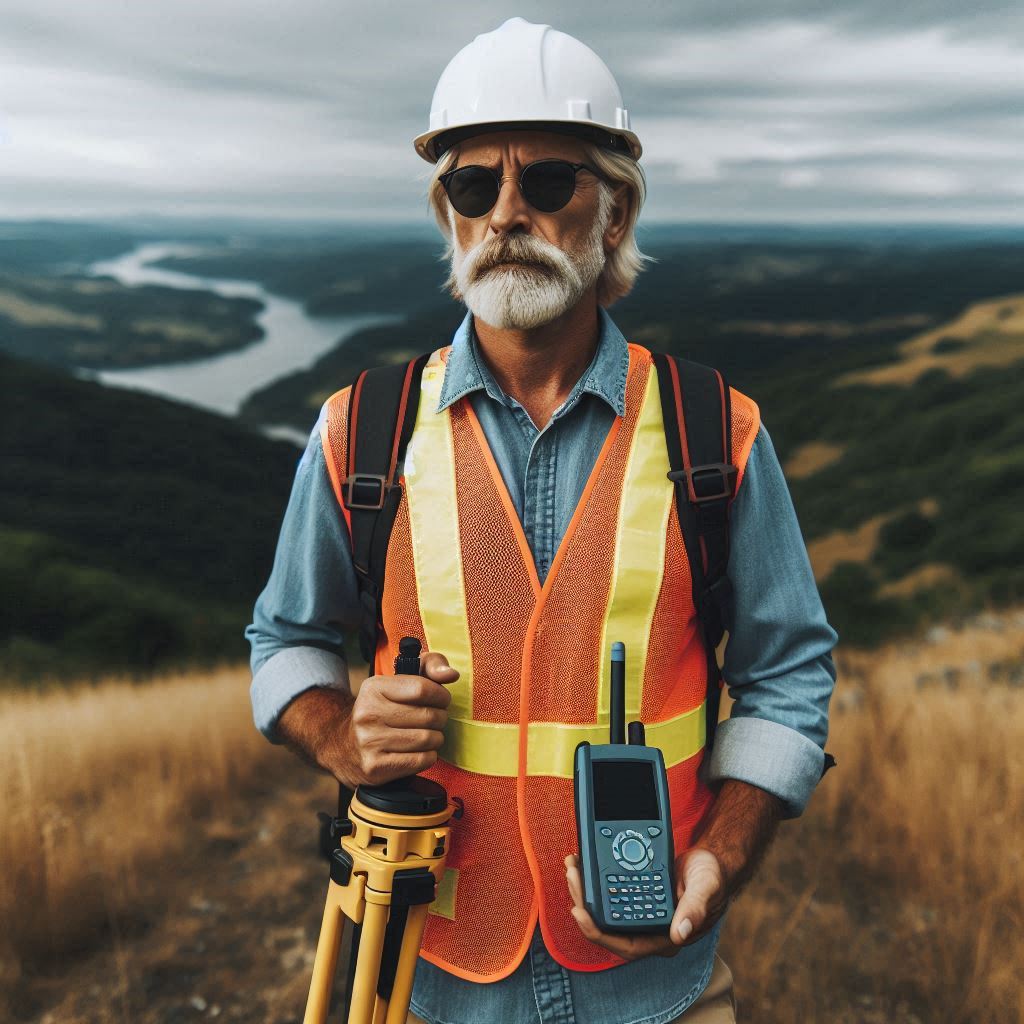Introduction
Introduce GIS (Geographic Information System)
GIS, or Geographic Information System, is a technology for managing and analyzing spatial data.
It combines hardware, software, and data to visualize and interpret geographic information.
The Importance of GIS in Various Fields
GIS plays a crucial role across many fields, including urban planning, environmental management, and transportation.
Its ability to analyze and display spatial relationships makes it invaluable for decision-making.
State the Purpose of the Blog Post
This blog post aims to explore how GIS is transforming the surveying profession.
We discuss its benefits and how it enhances efficiency and accuracy in surveying tasks.
In summary, GIS technology has revolutionized the surveying profession.
It enhances accuracy, speeds up data collection, and provides powerful analysis tools.
Surveyors now leverage GIS for real-time updates and better decision-making.
The integration of GIS leads to more efficient workflows and improved project outcomes.
Its impact on mapping, data management, and spatial analysis is profound.
Embracing GIS allows surveyors to stay competitive and deliver higher-quality results.
The adoption of GIS tools is crucial for modern surveying practices.
We encourage professionals to explore GIS further and integrate these technologies into their workflows.
The future of surveying hinges on the effective use of GIS.
Investing time and resources in learning and applying GIS will yield significant benefits.
Overview of GIS in Surveying
How GIS is Used in Surveying
Geographic Information Systems (GIS) revolutionize the surveying profession by integrating spatial data with advanced tools.
Surveyors use GIS to analyze and visualize geographical information with high precision.
By layering multiple datasets, GIS provides a comprehensive view of land features, which enhances measurement accuracy and decision-making.
The Benefits of Using GIS in Surveying
GIS offers several key benefits in surveying.
Firstly, it significantly improves accuracy.
Surveyors can overlay various data layers, leading to more precise measurements and analyses.
Secondly, GIS facilitates efficient data management.
It organizes and retrieves large volumes of spatial data quickly, which streamlines workflow and reduces manual data handling.
Another major advantage is enhanced decision-making.
GIS provides detailed visualizations through maps and 3D models, which help surveyors and clients make informed choices.
Additionally, GIS improves communication.
Interactive maps and spatial data presentations simplify the understanding of complex geographic information for all stakeholders involved.
Examples of GIS Applications in Surveying
Several examples demonstrate GIS applications in surveying.
In urban planning, GIS is used to map infrastructure, zoning, and land use.
Surveyors create detailed maps to plan new developments or assess current conditions.
In environmental monitoring, GIS helps track land use changes, vegetation, and natural resources, supporting conservation efforts.
Transportation planning benefits from GIS as well.
Surveyors map roads, railways, and transit systems using GIS to analyze traffic patterns and optimize routes.
In construction, GIS assists with site analysis, helping surveyors evaluate terrain and identify potential issues before building begins.
Agriculture also sees significant advantages from GIS.
Precision farming utilizes GIS to map soil types, crop health, and irrigation patterns, aiding farmers in making data-driven decisions to improve crop yields and resource management.
In disaster management, GIS plays a crucial role by assessing damage, planning recovery efforts, and managing resources during emergencies.
Overall, GIS transforms the surveying profession by enhancing accuracy, improving data management, and supporting better decision-making.
Its applications across various fields demonstrate its value in providing detailed analyses and effective solutions.
As GIS technology evolves, its impact on surveying will continue to grow, driving innovation and efficiency in the industry.
Read: The Role of Aerospace Engineers in Satellite Development
Improved Data Collection and Accuracy
How GIS Technology Improves Data Collection Methods
GIS technology enhances data collection methods by integrating spatial data with advanced tools and techniques.
Traditional surveying methods often rely on manual measurements and paper maps, which can be time-consuming and prone to errors.
GIS automates data collection through digital mapping and satellite imagery, allowing surveyors to capture large amounts of data quickly and efficiently.
Mobile GIS applications enable field data collection using tablets and smartphones, streamlining the process and reducing the need for manual data entry.
How GIS Helps in Achieving More Accurate Survey Results
GIS significantly improves the accuracy of survey results.
By layering and analyzing multiple datasets, GIS provides a more detailed and precise picture of geographic features.
This integration allows surveyors to cross-check data from various sources, reducing errors and inconsistencies.
Additionally, GIS enables real-time data processing and analysis.
Surveyors can immediately visualize and correct discrepancies, leading to more accurate and reliable results.
Advanced GIS tools also offer high-resolution satellite imagery and aerial photography, which enhances measurement precision.
These tools allow surveyors to capture detailed geographic information that traditional methods might miss.
Moreover, GIS software includes built-in error-checking algorithms that help identify and rectify inaccuracies in the data, further improving the overall quality of the survey results.
Real-Life Examples of Improved Accuracy in Surveying Projects
Several real-life examples highlight the improved accuracy achieved through GIS technology.
In urban planning, GIS has been used to develop detailed city models that accurately represent infrastructure, land use, and zoning.
These models support precise planning and development decisions, ensuring that new projects align with existing conditions and regulations.
In environmental conservation, GIS has played a crucial role in monitoring and preserving natural habitats.
For example, GIS technology has been used to map wetlands and track changes in vegetation over time.
This detailed information helps conservationists make informed decisions about protecting and restoring these critical ecosystems.
Another example is the use of GIS in transportation infrastructure projects.
GIS technology has been employed to analyze traffic patterns, optimize route planning, and improve road safety.
Accurate spatial data has enabled planners to design more effective transportation systems, reducing congestion and enhancing overall efficiency.
In agriculture, GIS has been utilized for precision farming, improving crop management and yield predictions.
By analyzing soil types, irrigation patterns, and crop health, farmers can make data-driven decisions that enhance productivity and resource use.
This approach has led to significant improvements in crop yields and overall farm efficiency.
Overall, GIS technology enhances data collection and accuracy in surveying by providing advanced tools and methods for capturing and analyzing spatial data.
Real-life examples demonstrate its effectiveness in various fields, underscoring its importance in achieving precise and reliable survey results.
Read: Aerospace Engineering in Commercial Spaceflight
Enhanced Efficiency and Productivity
How GIS Streamlines Surveying Processes
GIS streamlines surveying processes by integrating multiple tools and data sources into a cohesive system.
Traditional surveying often involves separate steps for data collection, analysis, and visualization, which can be time-consuming and complex.
GIS consolidates these tasks into a single platform, allowing surveyors to collect, analyze, and visualize spatial data efficiently.
This integration reduces the need for manual data handling and minimizes the potential for errors.
GIS also enhances workflow efficiency by automating repetitive tasks.
For example, GIS software can automatically generate maps and spatial analyses based on input data.
This automation speeds up the process and allows surveyors to focus on more critical aspects of their work.
Additionally, GIS enables real-time data sharing and collaboration, allowing teams to work together more effectively and make faster decisions.
How GIS Reduces Manual Labor and Time in Surveying Tasks
GIS significantly reduces manual labor and time in surveying tasks.
In traditional surveying, data collection often involves manual measurements and fieldwork, which can be labor-intensive and time-consuming.
GIS technology simplifies this process by using digital tools for data collection and analysis.
Mobile GIS applications enable surveyors to collect data directly in the field using tablets or smartphones, reducing the need for manual data entry and transcription.
GIS also accelerates data processing and analysis.
Traditional methods may require hours or days to compile and analyze data, whereas GIS can handle large datasets quickly and accurately.
Advanced GIS tools can perform complex spatial analyses in minutes, providing surveyors with valuable insights and reducing the time required for decision-making.
Moreover, GIS helps to reduce the need for repetitive field visits.
By integrating various data layers and providing detailed visualizations, GIS allows surveyors to plan and execute projects more efficiently.
This reduces the number of trips required to the field and minimizes the associated costs and time commitments.
Case Studies of Increased Efficiency and Productivity in Surveying Operations
One case study showcasing increased efficiency through GIS is the City of Los Angeles’ infrastructure management project.
By implementing GIS technology, the city was able to create a comprehensive database of its infrastructure, including roads, utilities, and public assets.
This GIS-based system streamlined data management, reduced the need for manual updates, and improved overall productivity in maintaining and planning infrastructure projects.
Another example is the use of GIS in land surveying for a large-scale renewable energy project.
Surveyors employed GIS to map potential sites for wind turbines and solar panels.
GIS technology enabled them to analyze geographical and environmental factors quickly, leading to faster site selection and reduced project timelines.
The efficiency gained through GIS allowed the project to move forward more swiftly and cost-effectively.
In agriculture, a precision farming initiative utilized GIS to optimize field management.
By analyzing soil data, crop health, and irrigation patterns, farmers could make informed decisions that increased productivity and reduced resource use.
The use of GIS technology significantly improved farm efficiency, leading to higher crop yields and more sustainable farming practices.
Overall, GIS enhances efficiency and productivity in surveying by streamlining processes, reducing manual labor, and accelerating data analysis.
Real-life case studies demonstrate its impact, highlighting the benefits of integrating GIS technology into surveying operations.
Read: Exploring Subfields of Aerospace Engineering

Integration with Other Technologies
How GIS Integrates with Drones, GPS, and Other Surveying Technologies
GIS integrates seamlessly with various technologies, including drones, GPS, and other surveying tools.
Drones provide high-resolution aerial imagery, which can be directly fed into GIS platforms for detailed spatial analysis.
GPS technology enhances GIS by providing precise location data, allowing for accurate mapping and tracking of survey points.
Together, these technologies enable surveyors to capture and analyze geographic information with unprecedented detail and accuracy.
Drones equipped with cameras and sensors can collect large volumes of data from above, offering a bird’s-eye view of the surveyed area.
This data can be processed and analyzed within a GIS system to create detailed maps and 3D models.
Similarly, GPS devices provide real-time location data, which integrates with GIS to improve the precision of spatial analyses and ensure that all data points are accurately represented.
The Advantages of Combining GIS with Other Tools for Surveying Projects
Combining GIS with other tools enhances the effectiveness of surveying projects in several ways.
One major advantage is improved accuracy.
When GIS is used alongside GPS, the location data becomes highly precise, which minimizes errors in mapping and spatial analysis.
Drones add another layer of detail by providing high-resolution imagery and capturing data from difficult-to-reach areas.
Another benefit is increased efficiency.
GIS technology can process and analyze data from drones and GPS devices in real-time, which accelerates the workflow and reduces the time required for data collection and analysis.
This integration also facilitates better data management.
GIS consolidates data from multiple sources into a single platform, making it easier to organize, visualize, and interpret complex datasets.
Additionally, combining GIS with other tools supports more comprehensive analyses.
For example, GIS can integrate environmental data from drones with GPS data on land use, allowing for in-depth assessments of environmental impact and planning.
This holistic approach provides a more complete understanding of the surveyed area and supports more informed decision-making.
The Seamless Workflow Achieved Through Technology Integration
Technology integration achieves a seamless workflow by connecting various tools and systems into a unified process.
For instance, when surveyors use drones for data collection, the captured imagery and data are automatically synchronized with GIS software.
This integration ensures that all data is accurately aligned and readily accessible for analysis.
GPS devices complement this process by providing precise location coordinates that enhance the accuracy of the data being integrated into the GIS system.
The combination of these technologies eliminates the need for manual data entry and reduces the risk of errors.
The real-time synchronization of data from drones, GPS, and GIS allows surveyors to monitor progress, make adjustments, and finalize analyses more efficiently.
In summary, integrating GIS with drones, GPS, and other surveying technologies enhances accuracy, efficiency, and data management.
The seamless workflow achieved through this technology integration streamlines surveying projects, providing surveyors with powerful tools to capture, analyze, and utilize spatial data effectively.
Read: Biomedical Engineer: Working in Healthcare Tech
Transform Your Career Today
Unlock a personalized career strategy that drives real results. Get tailored advice and a roadmap designed just for you.
Start NowCost-Effectiveness in Surveying
How GIS Helps in Cost Savings for Surveying Projects
GIS contributes to cost savings in surveying projects by optimizing various aspects of the process.
Traditional surveying methods often involve extensive fieldwork, manual data entry, and repetitive tasks, which can be costly and time-consuming.
GIS technology reduces these costs by automating data collection and processing.
Digital tools replace manual measurements, cutting down the time and labor required for surveys.
GIS also minimizes the need for multiple field visits.
By integrating and analyzing data digitally, surveyors can identify and address potential issues before returning to the field.
This reduces travel expenses and the need for additional fieldwork, contributing to overall cost savings.
The Economic Benefits of Using GIS in Surveying Operations
The economic benefits of using GIS in surveying operations are substantial.
Firstly, GIS technology reduces labor costs by automating data collection and analysis.
This automation decreases the amount of manual work required, allowing surveyors to focus on more critical tasks and improving overall productivity.
Secondly, GIS enhances project efficiency.
By providing accurate and detailed spatial data, GIS helps in planning and decision-making, which minimizes errors and the need for costly rework.
The ability to visualize and analyze data in real-time allows surveyors to address issues promptly, avoiding delays and additional expenses.
Thirdly, GIS supports better resource management.
It helps surveyors allocate resources more effectively by providing insights into project requirements and potential challenges.
This improved planning leads to more cost-effective use of materials, equipment, and personnel.
Examples of Reduced Expenses Through GIS Implementation
Several examples illustrate how GIS implementation leads to reduced expenses.
One example is a large-scale urban development project where GIS was used to analyze land use and infrastructure.
By utilizing GIS for spatial analysis, the project team was able to identify optimal locations for new developments and infrastructure improvements.
This strategic planning reduced the need for extensive rework and adjustments, resulting in significant cost savings.
Another example is in environmental monitoring.
A conservation project used GIS to track and analyze changes in land use and vegetation.
By integrating satellite imagery and field data into GIS, the project team could make informed decisions about conservation strategies, reducing the need for costly manual surveys and fieldwork.
In transportation infrastructure, GIS was employed to optimize road planning and traffic management.
By analyzing traffic patterns and geographic data, planners were able to design more efficient transportation systems, reducing construction costs and improving traffic flow.
In agriculture, a precision farming initiative utilized GIS to manage irrigation and crop health.
By analyzing spatial data on soil types and crop conditions, farmers optimized irrigation practices and reduced water usage, leading to lower costs and increased crop yields.
Overall, GIS technology offers significant cost savings in surveying projects by reducing labor, improving efficiency, and supporting better resource management.
The economic benefits of GIS are evident in various fields, demonstrating its value in reducing expenses and enhancing the effectiveness of surveying operations.
Read: Graduate Studies in Biomedical Engineering
Improved Decision-Making in Surveying
How GIS Aids in Data Analysis and Visualization for Surveying Projects
GIS significantly enhances data analysis and visualization in surveying projects.
Traditional methods often present data in basic formats, which can limit understanding and interpretation.
GIS transforms this by providing dynamic, interactive maps and visualizations.
Surveyors can overlay multiple data layers—such as topography, infrastructure, and land use—creating comprehensive and detailed views of the surveyed area.
Advanced GIS tools enable sophisticated spatial analyses.
For example, GIS can perform spatial queries, identify patterns, and analyze relationships between different datasets.
This capability allows surveyors to uncover insights that might not be apparent from raw data alone.
Visual tools like 3D models and heat maps further enhance understanding, helping stakeholders grasp complex geographic information quickly and effectively.
How GIS Assists in Making Informed Decisions for Land Development and Infrastructure Projects
GIS plays a crucial role in making informed decisions for land development and infrastructure projects.
By integrating various data types, GIS provides a holistic view of the area under consideration.
For land development, GIS helps identify suitable sites based on factors like land use, environmental impact, and accessibility.
This comprehensive analysis supports better site selection and planning, ensuring that new developments align with existing conditions and regulations.
In infrastructure projects, GIS assists in designing and optimizing layouts.
For instance, GIS can analyze traffic patterns, utility networks, and terrain to determine the best routes for roads or pipelines.
This analysis helps avoid costly errors and adjustments during construction.
GIS also supports impact assessments by visualizing potential effects on the environment and surrounding areas, aiding in compliance with regulatory requirements.
Examples of Improved Decision-Making Processes Due to GIS Technology
Several examples illustrate how GIS technology enhances decision-making processes:
- Urban Planning: In a major city redevelopment project, GIS was used to analyze land use patterns, infrastructure, and population density. The detailed GIS analysis allowed planners to make informed decisions about zoning, public transportation routes, and land allocation. This comprehensive approach led to more effective urban design and improved community outcomes.
- Environmental Management: A conservation project utilized GIS to map and analyze habitats and environmental resources. By integrating satellite imagery and field data, the project team could identify areas of ecological significance and make strategic decisions about conservation efforts. GIS also helped in assessing the impact of proposed developments on natural habitats, leading to more sustainable decision-making.
- Transportation Planning: In a regional transportation improvement project, GIS was employed to analyze traffic congestion and identify optimal routes for new roadways. GIS tools helped visualize traffic patterns and potential bottlenecks, leading to better route planning and reduced traffic congestion. The integration of GIS data into the planning process resulted in a more efficient transportation network.
- Disaster Management: During a natural disaster response, GIS was used to assess damage, map affected areas, and coordinate recovery efforts. By visualizing the extent of damage and infrastructure conditions, emergency responders could prioritize resources and make informed decisions about recovery strategies. GIS technology enabled a more organized and effective response to the disaster.
Overall, GIS enhances decision-making in surveying by providing powerful tools for data analysis and visualization.
Its ability to integrate and interpret complex datasets supports more informed and strategic decisions in land development, infrastructure projects, and beyond.
Training and Education in GIS for Surveyors
The Importance of GIS Training for Surveying Professionals
GIS training is crucial for surveying professionals due to the increasing reliance on GIS technology in the field.
Understanding how to effectively use GIS tools and software enables surveyors to enhance their data collection, analysis, and visualization capabilities.
Training equips professionals with the skills needed to integrate GIS with traditional surveying methods, leading to more accurate and efficient results.
As GIS technology evolves, staying current with the latest tools and techniques ensures that surveyors can fully leverage the benefits of GIS, improving their overall performance and competitiveness in the industry.
The Need for Continuous Education and Skill Development in GIS for Surveyors
Continuous education and skill development in GIS are essential for surveyors to keep pace with technological advancements and industry changes.
GIS technology is rapidly evolving, with new software, tools, and methodologies regularly emerging.
To remain effective and relevant, surveyors must engage in ongoing learning to stay updated with the latest innovations and best practices.
Regular training helps surveyors adapt to new features and functionalities of GIS software, improving their ability to handle complex projects.
It also fosters professional growth, allowing surveyors to specialize in advanced GIS applications, such as 3D modeling or spatial analysis.
Investing in continuous education enhances career prospects and supports the adoption of cutting-edge technologies in surveying practices.
Resources and Recommendations for GIS Training Programs for Surveying Professionals
Several resources and training programs are available to support GIS education for surveying professionals:
- Esri Training: Esri offers a range of online courses, webinars, and certification programs through its Esri Training website. Courses cover various aspects of GIS, from beginner to advanced levels, and include practical applications for surveying professionals.
- Coursera: Coursera provides GIS courses from renowned institutions, such as the University of California, Davis. These online courses cover GIS fundamentals, spatial analysis, and data visualization, offering flexibility for busy professionals.
- Udemy: Udemy offers a variety of GIS courses tailored to different skill levels. Courses include practical exercises and real-world examples, making it easier for surveyors to apply their learning to their work.
- Local Universities and Colleges: Many universities and colleges offer GIS certification programs and workshops. These programs often provide hands-on experience with GIS software and tools, along with in-depth knowledge relevant to surveying.
- Professional Organizations: Joining professional organizations, such as the American Society for Photogrammetry and Remote Sensing (ASPRS) or the International Association of Geodesy (IAG), can provide access to industry conferences, workshops, and networking opportunities focused on GIS and surveying.
- Online Communities and Forums: Participating in online forums and communities, such as GIS Stack Exchange or Reddit’s GIS subreddit, can offer valuable insights and peer support. These platforms allow surveyors to discuss challenges, share experiences, and learn from others in the field.
Investing in GIS training and continuous education enhances the skills and knowledge of surveying professionals.
By leveraging available resources and staying current with technological advancements, surveyors can improve their expertise and contribute to more effective and efficient surveying practices.
Conclusion
The Key Points Discussed in the Blog Post
GIS technology has significantly impacted the surveying profession, offering numerous benefits.
It improves accuracy in data collection and enhances spatial analysis capabilities.
Surveyors now utilize GIS for real-time data updates, which streamlines their workflow and increases efficiency.
This technology enables advanced mapping techniques and better data management, leading to more precise and reliable survey results.
The Significance of GIS in Changing the Surveying Profession
The significance of GIS in surveying cannot be overstated.
It transforms traditional methods by integrating spatial data with real-time analytics.
GIS technology allows surveyors to visualize complex datasets more clearly and make informed decisions quickly.
This shift enhances overall project outcomes and ensures higher quality in surveying tasks.
Encourage Further Exploration and Adoption of GIS Technology in Surveying Practices
Surveyors should actively explore and adopt GIS technology to stay competitive and innovative.
Embracing GIS opens up new possibilities for improving efficiency and accuracy in surveying.
Investing in GIS technology and training will yield substantial benefits and drive future advancements in the field.
[E-Books for Sale]
The Big Book of 500 High-Paying Jobs in America: Unlock Your Earning Potential
$19.99 • 500 High-Paying Jobs • 330 pages
Explore 500 high-paying jobs in America and learn how to boost your career, earn more, and achieve success!
See All 500 High-Paying Jobs of this E-Book
1001 Professions Without a Degree: High-Paying American Jobs You Can Start Now
$19.99 • 1001 Professions Without a Degree • 174 pages
Discover 1001 high-paying jobs without a degree! Unlock career tips, skills, and success strategies for just $19.99!




